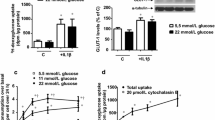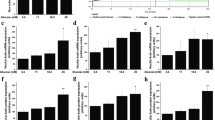Abstract
The alteration and further damage of vascular smooth muscle function have been implicated in the development of vascular complications and diabetes. Little is known about protein tyrosine nitration in vascular smooth muscle cell injury induced by high glucose. In this article, vascular smooth muscle cell was exposed to 30 and 40 mM high glucose for 72 h, and then the cell injury in vascular smooth muscle cell induced by high glucose was studied. It was found that high glucose stimulated vascular smooth muscle cell injury in a dose-dependent manner, including decreasing intracellular and extracellular glutathione contents, increasing malondialdehyde and intracellular reactive oxygen species content, increasing the production of nitric oxide (increased nitrite content in cell and medium), as well as increasing protein tyrosine nitration. By comparing protein tyrosine nitration induced by high glucose conditions and extrinsic factors (hemin–nitrite–glucose oxidase system and 3-morpholinosydnonimine), it may be speculated that protein is nitrated selectively, and specific protein tyrosine nitration is involved in diabetic vascular complications.







Similar content being viewed by others
References
Adachi T, Matsui R, Xu S, Kirber M, Lazar HL, Sharov VS, Schoneich C, Cohen RA (2002) Antioxidant improves smooth muscle sarco/endoplasmic reticulum Ca(2+)-ATPase function and lowers tyrosine nitration in hypercholesterolemia and improves nitric oxide-induced relaxation. Circ Res 90(10):1114–1121
Baynes JW (1991) Role of oxidative stress in development of complications in diabetes. Diabetes 40:405–412
Baynes JW, Thorpe SR (1999) Role of oxidative stress in diabetic complications: a new perspective on an old paradigm. Diabetes 48:1–9
Bonnefont-Rousselot D, Bastard JP, Jaudon MC, Delattre J (2000) Consequences of the diabetic status on the oxidant/antioxidant balance. Diabet Metabol 26(3):163–176
Bosse HM, Bachmann S (1997) Immunohistochemically detected protein nitration indicates sites of renal nitric oxide release in Goldblatt hypertension. Hypertension 30(4):948–952
Carmody BJ, Arora S, Wakefield MC, Weber M, Fox CJ, Sidawy AN (2002) Progesterone inhibits human infragenicular arterial smooth muscle cell proliferation induced by high glucose and insulin concentrations. J Vasc Surg 36(4):833–838
Ceriello A (2006) Oxidative stress and diabetes-associated complications. Endocr Pract 12(1):S60–S62
Coccheri S (2007) Approaches to prevention of cardiovascular complications and events in diabetes mellitus. Drugs 67(7):997–1026
Cosentino F, Hishikawa K, Katusic ZS (1997) High glucose increases nitric oxide synthase expression and superoxide anion generation in human aortic endothelial cells. Circulation 96(1):25–28
Deeb RS, Resnick MJ, Mittar D, McCaffrey T, Hajjar DP, Upmacis RK (2002) Tyrosine nitration in prostaglandin H2 synthase. J Lip Res 43:1718–1726
Fries DM, Paxinou E, Themistocleous M, Swanberg E, Griendling KK, Salvemini D, Slot JW, Heijnen HF, Hazen SL, Ischiropoulos H (2003) Expression of inducible nitric-oxide synthase and intracellular protein nitration in vascular smooth muscle cells. J Biol Chem 278(25):22901–22907
Giugliano D, Ceriello A, Paolisso G (1996) Oxidative stress and diabetic vascular complications. Diabetes care 19(3):257–267
Graier WF, Grubenthal I, Dittrich P, Wascher TC, Kostner GM (1995) Intracellular mechanism of high d-glucose-induced modulation of vascular cell proliferation. Eur J Pharmacol 294(1):221–229
Graier WF, Posch K, Fleischhacker E, Wascher TC, Kostner GM (1999) Increased superoxide anion formation in endothelial cells during hyperglycemia: an adaptive response or initial step of vascular dysfunction? Diabetes Res Clin Pract 45(2–3):153–160
Haffner SM (1998) The importance of hyperglycemia in the nonfasting state to the development of cardiovascular disease. Endocr Rev 19(5):583–592
Hissin PJ, Hilf RA (1976) Fluorimetric method for determination of oxidized and reduced glutathione in tissues. Anal Biochem 74(1):214–226
Hsieh CC, Lau YT (1998) Migration of vascular smooth muscle cells is enhanced in cultures derived from spontaneously hypertensive rat. Pflug Arch Eur J Phys 435(2):286–292
Jiao HL, Ye P, Zhao BL (2003) Protective effects of green tea polyphenols on human HepG2 cells against oxidative damage of fenofibrate. Free Radic Biol Med 35(9):1121–1128
Kannel WB, McGee DL (1978) Diabetes and cardiovascular disease. The Framingham study. JAMA 241(19):2035–2038
Li Y, Zhu H, Stransbury KH, Trush MA (1997) Oxygen radicals and disease process. Harwood Academic Publishers, Amsterdam, pp 327–377
Narayan KM, Boyle JP, Thompson TJ, Sorensen SW, Williamson DF (2003) Lifetime risk for diabetes mellitus in the United States. JAMA 290(14):1884–1890
Nareika A, Im YB, Game BA, Slate EH, Sanders JJ, London SD, Lopes-Virella MF, Huang Y (2008) High glucose enhances lipopolysaccharide-stimulated CD14 expression in U937 mononuclear cells by increasing nuclear factor κB and AP-1 activities. J Endocrinol 196(1):45–55
Natarajan R, Gonzales N, Xu L, Nadler JL (1992) Vascular smooth muscle cells exhibit increased growth in response to elevated glucose. Biophys Biochem Res Commun 187(1):552–560
Nishikawa T, Edelstein D, Du XL, Yamagishi S, Matsumura T, Kaneda Y, Yorek MA, Beebe D, Oates PJ, Hammes HP, Giardino I, Brownlee M (2000) Normalising mitochondrial superoxide production blocks three pathways of hyperglycemic damage. Nature 404(6779):787–790
Numata M, Suzuki S, Miyazawa N, Miyashita A, Nagashima Y, Inous S, Kaneko T, Okubo T (1998) Inhibition of inducible nitric oxide synthase prevents LPS-induced acute lung injury in dogs. J Immunol 160(6):3031–3037
Oberley LW (1988) Free radicals and diabetes. Free Radic Biol Med 5(2):113–124
Ohshima H, Tsuda M, Adachi H, Ogura T, Sugimura T, Esumi H (1991) l-Arginine-dependent formation of N-nitrosamines by the cytosol of macrophages activated with lipopolysaccharide and interferon-γ. Carcinogenesis 12(7):1217–1220
Palmer RMJ, Ashtibm DS, Moncada S (1987) Vascular entothelial cells synthesize nitric oxide form l-arginine. Nature 333:664
Peluffo G, Radi R (2007) Biochemistry of protein tyrosine nitration in cardiovascular pathology. Cardiovasc Rea 75:291–302
Peterson GL (1977) A simplification of the protein assay and method of Lowry et al., which is more generally applicable. Anal Biochem 83(2):346–350
Rajeswari O, Natarajan R, Nadler JL, Kumar D, Kalra VK (1991) Glucose induces lipid peroxidation and inactivation of membrane-associated ion-transport enzymes in human erythrocytes in vivo and in vitro. J Cell Physiol 149(1):100–109
Ross R (1986) The pathogenesis of atherosclerosis-an update. N Engl J Med 314(8):488–500
Spitaler MM, Graier WF (2002) Vascular targets of redox signalling in diabetes mellitus. Diabetologia 45(4):476–494
Tachi Y, Okuda Y, Bannai C, Okamura N, Bannai S, Yamashita K (1998) High concentration of glucose causes impairment of the function of the glutathione redox cycle in human vascular smooth muscle cells. FEBS Let 421(1):19–22
Uemura S, Matsushita H, Li W, Glassford AJ, Asagami T, Lee KH, Harrison DG, Tsao PS (2001) Diabetes mellitus enhances vascular matrix metalloproteinase activity: role of oxidative stress. Cir Res 88(12):1291–1298
van der Vliet A, Eiserich JP, Halliwell B, Cross CE (1997) Formation of reactive nitrogen species during peroxidase-catalyzed oxidation of nitrite. A potential additional mechanism of nitric oxide-dependent toxicity. J Biol Chem 272(12):7617–7625
Williamson JR, Chang K, Fragos M, Hasan KS, Ido Y, Kawamura T, Nyengaard JR, van den Enden M, Kilo C, Tilton RG (1993) Hyperglycemic pseudohypoxia and diabetic complications. Diabetes 42(6):801–813
Ye J, Wang S, Leonard SS, Sun Y, Butterworth L, Antonini J, Ding M, Rojanasakul Y, Vallyathan V, Castranova V, Shi X (1999) Role of reactive oxygen species and p53 in chromium(VI)-induced apoptosis. J Biol Chem 274(49):34974–34980
Zhao YL, Gao ZH, Li HL, Xu HB (2004) Hemin/nitrite/H2O2 induces brain homogenate oxidation and nitration: effects of some flavonoids. Biochim Biophys Acta 1675:105–112
Zhao YL, Li HL, Gao ZH, Gong YF, Xu HB (2006) Effects of flavonoids extracted from Scutellaria baicalensis Georgi on hemin-nitrite-H2O2 induced liver injury. Eur J Pharmacol 536(1–2):192–199
Zhao YL, Lu NH, Li HL, Zhang Y, Gao ZH, Gong YF (2008) High glucose induced human umbilical vein endothelial cell injury: involvement of protein tyrosine nitration. Mol Cell Biochem 311:19–29
Acknowledgment
This work was supported by grants from the National Natural Science Foundation of China (no. 30300073), the Research Found of the Department of Education of Zhejiang Province (Y201016792), the Program for Doctor Scientific Research Found of Zhejiang Normal University (ZC304009077), and New Century Excellent Talents in University (no. NCET-05-0649).
Author information
Authors and Affiliations
Corresponding author
Rights and permissions
About this article
Cite this article
Zhao, Y., Lu, N., Zhang, Y. et al. High glucose induced rat aorta vascular smooth muscle cell oxidative injury: involvement of protein tyrosine nitration. J Physiol Biochem 67, 539–549 (2011). https://doi.org/10.1007/s13105-011-0099-x
Received:
Accepted:
Published:
Issue Date:
DOI: https://doi.org/10.1007/s13105-011-0099-x




